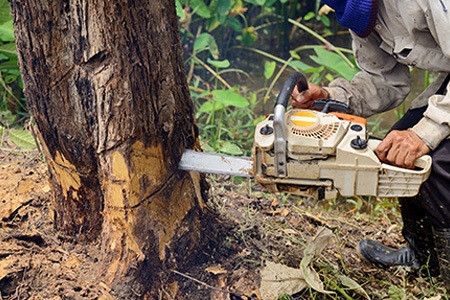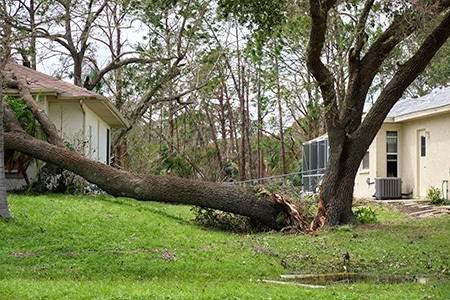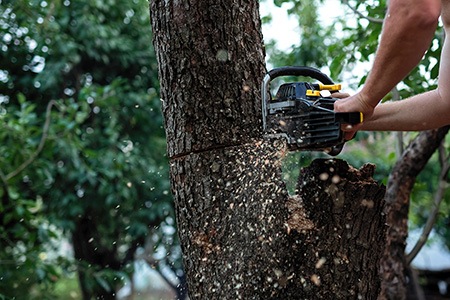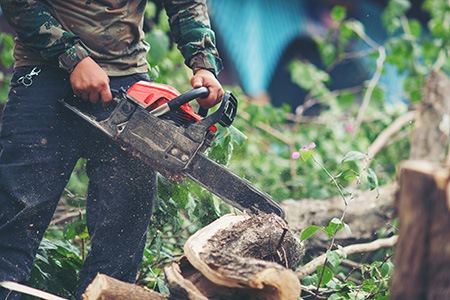What's the Cheapest Time of Year for Tree Removal?
Author: Chris Miller | Editor: Omar Alonso
Review & Research: Jen Worst & Chris Miller

Do you have a tree looming dangerously over your home? It's time to remove it before it crashes onto the roof, causing massive amounts of property damage. Removing a tree might be expensive, but it will be much more affordable than repairing the damage to your roof. But what's the cheapest time of year for tree removal?
While trees are beautiful and prized possessions in any yard, sometimes they can be a nuisance and be highly destructive. Branches might fall from a dead tree, roots can upheave driveways and foundations, and extreme weather events might blow the tree onto your home in the middle of the night.
If you have no experience with felling trees, you'll need to call a professional to do the job for you. However, you'll have to pay them for the service, and tree removal is a costly undertaking. However, tree felling services charge different seasonal prices. So, what's the cheapest time of year to have a tree cut down?
Typically, the most affordable time of the year to hire a tree felling service is from the late winter to early spring. You'll usually get the best rates on tree felling in February. When trees are dormant during this time, they're easier to manage. The leaves are gone, and the branches are easier to handle.
The price of tree felling services varies depending on your area, the type of tree needing removal, and the service provider you hire.
Best Time to Remove Trees by Expected Costs

The time of the year and the type of tree requiring felling present the biggest cost factors when estimating the price of the removal service. For instance, removing a large oak tree will cost much more than a smaller pine tree.
The type of felling required for removal also impacts the costs of the felling service. If the tree feller must use specialized equipment to prevent the tree from falling on your roof, it adds to the estimate. If the job is low-risk, it will cost much less. Sometimes it's as simple as notching the tree and letting it fall.
The company you hire for the job also significantly affects costs. Some services charge more than others because they do the job faster and clear the tree from your property after removal. Here's a rough guide on what you can expect for tree removal according to size.
- Small trees (30 to 60 feet) $300 to $750
- Medium trees (70 to 80 feet) $850 to $1,000
- Large trees (80 feet and over) $1,150 to $2,500
These numbers are just a guideline. The price quoted by the tree felling service will vary, depending on your area, the risk involved in the job, and the quality and track record of the company you use, and the time of year (which affects how busy they are).
The cheapest time of year for tree removal will be after late winter and before spring gets too far into swing. Get an estimate for the work from three or four service providers and compare costs and quality of service before appointing a company.
It's also important to note that most tree felling companies won't include stump removal and grinding in their estimate. You'll have to pay more for these services; not all tree fellers offer them. You might consider hollowing out the tree stump to use for neat gardening, or kill the tree stump on your own for an easier self-removal later.
Reasons for Removing Trees from Your Property

The reasons for tree removal vary depending on the situation. In some cases, removing a tree might be for safety concerns, such as the threat of it falling on the house.
In other cases, it may require removal because you're developing the land. Sometimes, there may be no reason to remove the tree. For instance, the tree might get close to electrical lines and only require trimming.
However, there are cases where removing the tree is the only option. Here are some instances where you'll have to call the tree felling service.
- The tree is leaning over your home or the neighbor's property boundary.
- The roots are upheaving the driveway or the foundations of the house.
- The tree has a termite, wood mite, or pest infestation that might spread to the home or nearby trees.
- A diseased tree might spread the pathogen to nearby trees or vegetation, and you can't save the dying tree.
- The tree has dead limbs presenting the risk of property damage to the home or other structures like the wall.
Unless the tree presents a fall risk in the near future, holding on to the right season to have it removed can save you a bundle on removal fees.
Understanding Seasonality & Tree Removal

The busy season for tree removal is between the winter and springtime. The most affordable time of year to have a tree removed is when it's still dormant, usually around February in the Northern Hemisphere.
Tree removal services are available year-round, but waiting until February can save you a stack of cash, with rates typically being 25% lower. However, if you have the tree removed, it's better to wait till after the summer rains to remove the stump, as most companies struggle to remove them when the ground is frozen, adding to labor costs.
Only attempt to fell a tree if you have the right tools for the job, a team to assist with the process, and experience with felling trees. For most homeowners, you'll need to call a professional felling service to handle the job.
The tree doesn't have to present a threat of damage to property to have it removed; you can remove the tree for any reason. You might find the tree blocks your view of the mountain range behind your home, and you want to remove it for cosmetic purposes.
So then, what's the cheapest time of year for tree removal? Well, don't call the tree felling company the same week you want to remove the tree. In most instances, you'll need to make an appointment for tree removal months in advance. Requiring removal in a week or two is considered an emergency. Most contractors will charge extra for booking an appointment in a week or two after calling them for removal services.
Plan in advance, and you'll save money on the job. For instance, if you notice a tree in your yard presents a fall risk, call a removal service before the storm season arrives. This is the busiest time of year for these companies, and you'll have trouble finding someone available. They'll charge you premium rates for the removal service if you do.
How Do You Get a Tree Removed if it's an Emergency?
Typically, a tree removal company will put you on a waitlist after you call them for their services. You can wait eight to 12 weeks for an appointment. That's an issue if you have a tree that looks like it might fall soon.
If you are in an emergency, there's a hack for getting around the waitlist with tree removal companies. Trees that risk damaging plumbing or power lines owned by the municipality present a financial risk to the city.
So, you can call the city hall and enquire about a removal service. You must explain the tree's risks to city property to qualify for emergency tree removal. City hall or the courthouse can advise you on contractors to call for emergency removal. The city might contract a tree felling service in some locations to handle these emergencies.
FAQs Regarding the Best Time of Year to Remove Trees

When it comes to the cheapest time of year to have a tree cut down, a lot of other questions arise when we start thinking about it. Let’s cover those now.
What Do Contractors Do With Trees After They Remove Them?
After a contractor cuts down a tree, they'll cut the trunk and branches into manageable sections and mulch the limbs. The contractor removes the waste from your property and disposes of it. Smart ones may sell the trunks for the lumber. Ensure that they include these costs in their estimate before approving the work. The contractor won't be responsible for removing the stump and roots; you'll need a separate service to do this for you.
How Much of a Tree Can You Remove Before Killing It?
If you remove the tree branches, it can't produce leaves which it uses to make food to fuel its growth. However, the roots might keep growing. Cutting away more than 15% of the above-ground roots kills the tree.
How Long Does it Take to Remove a Tree?
The time it takes to remove a tree depends on its size and position. For instance, if the tree is in a clearing with no structures around it, it's easier to remove than a tree looming over a roof. Likewise, a smaller tree will take less time to remove than a larger tree. The removal company will visit your property and give you an estimate of the time and costs for the job before they start the work.
Key Takeaways Regarding the Best Time to Remove Trees

- The cheapest time of the year to get a tree removed from your yard is between the end of winter to early spring – usually around February.
- The cost to remove the tree depends on its size and position. Some trees are harder to remove than others.
- You can remove a tree for several reasons. Pest infestations, disease, unruly root systems, and leaning trees presenting a fall risk are all valid reasons for tree removal.
- You can have a tree removed for cosmetic reasons as well.
- It can take several months to book an appointment for tree removal – book well in advance.
- If you need emergency tree removal, call your city hall for information.
That’s the Cheapest Time of Year for Tree Removal
The cheapest time of year for tree removal is between the end of winter and the earliest portions of spring, which would be around February in most of the United States.



